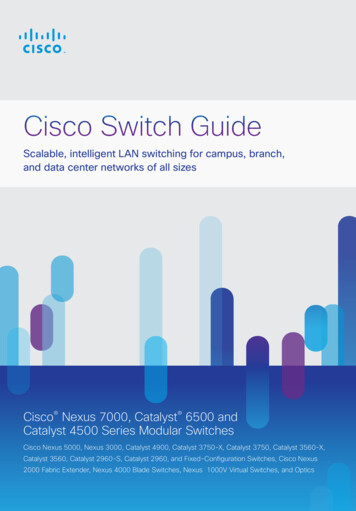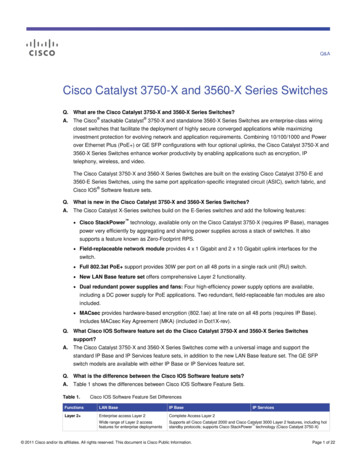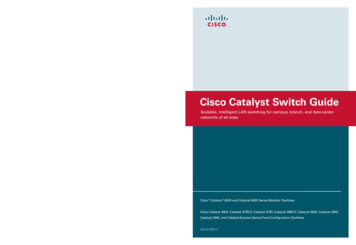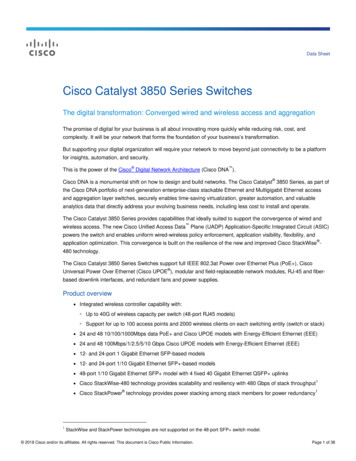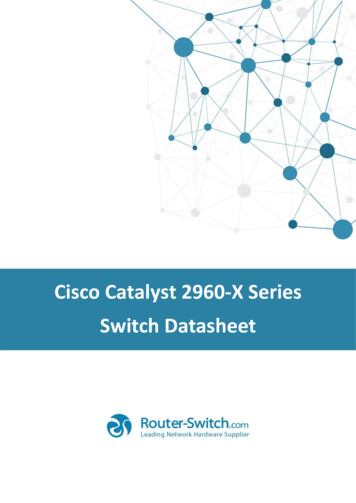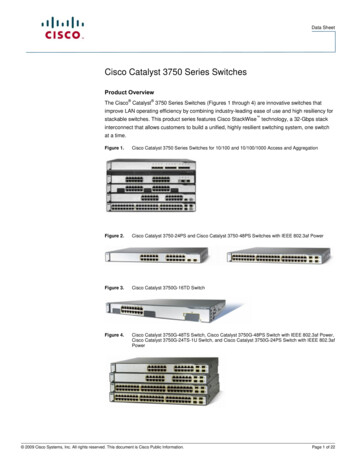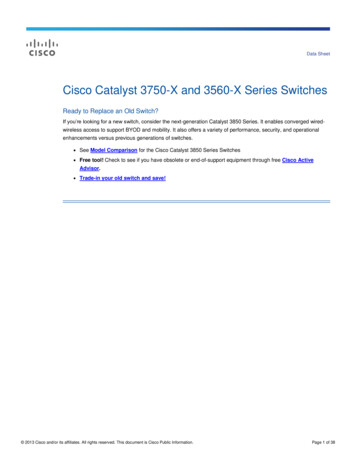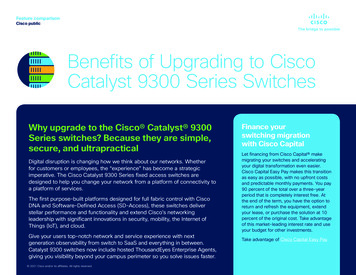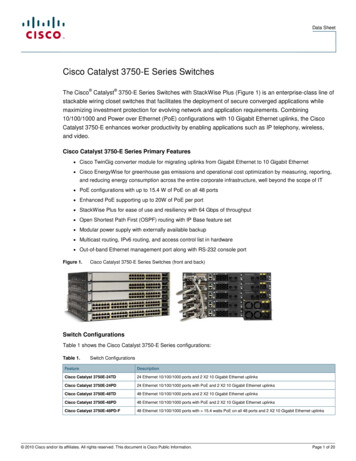
Transcription
Data SheetCisco Catalyst 3750-E Series Switches The Cisco Catalyst 3750-E Series Switches with StackWise Plus (Figure 1) is an enterprise-class line ofstackable wiring closet switches that facilitates the deployment of secure converged applications whilemaximizing investment protection for evolving network and application requirements. Combining10/100/1000 and Power over Ethernet (PoE) configurations with 10 Gigabit Ethernet uplinks, the CiscoCatalyst 3750-E enhances worker productivity by enabling applications such as IP telephony, wireless,and video.Cisco Catalyst 3750-E Series Primary Features Cisco TwinGig converter module for migrating uplinks from Gigabit Ethernet to 10 Gigabit Ethernet Cisco EnergyWise for greenhouse gas emissions and operational cost optimization by measuring, reporting,and reducing energy consumption across the entire corporate infrastructure, well beyond the scope of IT PoE configurations with up to 15.4 W of PoE on all 48 ports Enhanced PoE supporting up to 20W of PoE per port StackWise Plus for ease of use and resiliency with 64 Gbps of throughput Open Shortest Path First (OSPF) routing with IP Base feature set Modular power supply with externally available backup Multicast routing, IPv6 routing, and access control list in hardware Out-of-band Ethernet management port along with RS-232 console portFigure 1.Cisco Catalyst 3750-E Series Switches (front and back)Switch ConfigurationsTable 1 shows the Cisco Catalyst 3750-E Series configurations:Table 1.Switch ConfigurationsFeatureDescriptionCisco Catalyst 3750E-24TD24 Ethernet 10/100/1000 ports and 2 X2 10 Gigabit Ethernet uplinksCisco Catalyst 3750E-24PD24 Ethernet 10/100/1000 ports with PoE and 2 X2 10 Gigabit Ethernet uplinksCisco Catalyst 3750E-48TD48 Ethernet 10/100/1000 ports and 2 X2 10 Gigabit Ethernet uplinksCisco Catalyst 3750E-48PD48 Ethernet 10/100/1000 ports with PoE and 2 X2 10 Gigabit Ethernet uplinksCisco Catalyst 3750E-48PD-F48 Ethernet 10/100/1000 ports with 15.4 watts PoE on all 48 ports and 2 X2 10 Gigabit Ethernet uplinks 2010 Cisco and/or its affiliates. All rights reserved. This document is Cisco Public Information.Page 1 of 20
Data SheetCisco Catalyst 3750-E SoftwareCisco Catalyst 3750-E Series is available with either the IP Base or the IP Services feature set. The IP Base featureset includes advanced quality of service (QoS), a suite of security features, rate-limiting, access control lists, basicstatic, Routing Information Protocol (RIP), and OSPF routing capability. The IP Services feature set provides a richerset of enterprise-class features, including advanced hardware-based IP unicast and multicast routing—EnhancedInterior Gateway Routing Protocol (EIGRP), Open Shortest Path First (OSPF), Border Gateway Protocol (BGP),Protocol Independent Multicast (PIM), and IPv6 routing such as OSPFv3 and EIGRPv6.Customers can transparently upgrade the software feature set in the Cisco Catalyst 3750-E Series Switches through Cisco IOS Software Activation. Software activation authorizes and enables the Cisco IOS Software feature sets. Aspecial file contained in the switch, called a license file, is examined by Cisco IOS Software when the switch ispowered on. Based on the license’s type, Cisco IOS Software activates the appropriate feature set. License typescan be changed, or upgraded, to activate a different feature set. For detailed information about Software Activation,visit http://www.cisco.com/go/sa.Investment ProtectionThe Cisco Catalyst 3750-E Series Switches are compatible with the Cisco Catalyst 3750 Series Switches, enablingcustomers to stack them together and thereby protect existing investment in the Cisco Catalyst 3750 SeriesSwitches. The Cisco TwinGig Small Form-Factor Pluggable (SFP) converter module further protects customers’investment in Cisco Catalyst 3750-E Series Switches by enabling migration from Gigabit Ethernet to 10 GigabitEthernet uplinks, as business needs require, without having to upgrade the switches.Cisco StackWise Plus Technology Cisco StackWise Plus technology is built on the highly successful StackWise technology, which is a premiumstacking architecture optimized for Gigabit Ethernet. StackWise technology was designed to respond to additions,deletions, and redeployment while maintaining constant performance. The stack behaves as a single switching unitthat is managed by a master switch elected from one of the member switches. The master switch automaticallycreates and updates all the switching and optional routing tables. A working stack can accept new members ordelete old ones without service interruption. StackWise creates a highly resilient single unified system of up to nineswitches, providing simplified management using a single IP address, single telnet session, single command-lineinterface (CLI), auto-version checking, autoconfiguration, and more. StackWise Plus supports all the features ofStackWise and provides backward compatibility with the existing Cisco Catalyst 3750 Series Switches whileenhancing the throughput of the system up to 64 Gbps. StackWise Plus also enables local switching in CiscoCatalyst 3750-E Series Switches. Local switching packets coming into a port in the Cisco Catalyst 3750-E SeriesSwitch destined for another port in the same switch do not have to traverse through the stack ring, thus increasingthe forwarding capacity of the switch.Cisco EnergyWise TechnologyCisco EnergyWise is an innovative architecture, added to the Cisco Catalyst 3750-E switches, promotingcompanywide sustainability by reducing energy consumption across an entire corporate infrastructure and affectingmore than 50 percent of global greenhouse gas emissions created by worldwide building infrastructure, a muchgreater effect than the 2 percent generated by the IT industry. Cisco EnergyWise enables companies to measure thepower consumption of network infrastructure and network-attached devices and manage power consumption withspecific policies, reducing power consumption to realize increased cost savings, potentially affecting any powereddevice. 2010 Cisco and/or its affiliates. All rights reserved. This document is Cisco Public Information.Page 2 of 20
Data SheetEnergyWise encompasses a highly intelligent network-based approach to communicate messages that measureand control energy between network devices and endpoints. The network discovers Cisco EnergyWise manageabledevices, monitors their power consumption, and takes action based on business rules to reduce power consumption.EnergyWise uses a unique domain-naming system to query and summarize information from large sets of devices,making it simpler than traditional network management capabilities. Cisco EnergyWise’s management interfacesallow facilities and network management applications to communicate with endpoints and each other using thenetwork as a unifying fabric. The management interface uses standard SNMP or SSL to integrate Cisco and thirdparty management systems.Cisco EnergyWise extends the network as a platform for power control plane for gathering, managing, and reducingpower consumption of all devices, resulting in companywide optimized power delivery and reduced energy costs.10 Gigabit Ethernet Uplinks and the Cisco TwinGig SFP ConverterThe Cisco Catalyst 3750-E features wire-speed 10 Gigabit Ethernet uplink ports for high-bandwidth applications,relieving congestion and helping ensure smooth delivery of data. The TwinGig SFP converter (see Figure 2) convertsa 10 Gigabit Ethernet X2 interface into two Gigabit Ethernet SFP ports. This way, customers can initially use theswitch with Gigabit Ethernet uplinks and later implement 10 Gigabit Ethernet uplinks as business demands change,without having to upgrade the access layer.Figure 2.Cisco TwinGig Adapter Converting 10 Gigabit Ethernet X2 Interface into Two Gigabit Ethernet SFP InterfacesModular Power SuppliesThe Cisco Catalyst 3750-E Series Switches have one power supply slot and support the following power supplies.PoE switches require a PoE power supply. Data-only switches can operate with any of the power supplies. C3K-PWR-1150WAC: 1150WAC power supply with 800W PoE C3K-PWR-750WAC: 750WAC power supply for 24-port switch with 420W PoE C3K-PWR-265WAC: 265WAC power supply for 48-port or 24-port switch without PoE C3K-PWR-265WDC: 265WDC power supply for 48-port or 24-port switch without PoEMaximum power availability for converged voice and data networks is attainable when a Cisco Catalyst 3750-ESeries Switch is combined with the Cisco RPS 2300 Redundant Power System for transparent protection againstinternal power supply failures and an uninterruptible power supply (UPS) system to safeguard against poweroutages. Using the RPS 2300 to provide backup power, the Cisco Catalyst 3750-E Series Switch power suppliesbecome hot swappable. Table 3 shows the power supply compatibility matrix. 2010 Cisco and/or its affiliates. All rights reserved. This document is Cisco Public Information.Page 3 of 20
Data SheetPower over EthernetThe Cisco Catalyst 3750-E Series can provide a lower total cost of ownership for deployments that incorporate Cisco IP phones, Cisco Aironet wireless LAN (WLAN) access points, or any IEEE 802.3af-compliant end device. PoEremoves the need for wall power to each PoE-enabled device and eliminates the cost for additional electrical cablingand circuits that would otherwise be necessary in IP phone and WLAN deployments. The Cisco Catalyst 3750-E 24port PoE configurations can support 24 simultaneous full-powered PoE ports at 15.4W for full powered-devicesupport. The Cisco Catalyst 3750-E 48-port PoE configurations can support 48 simultaneous full-powered PoE portsat 15.4W when using the optional 1150W power supply. Alternatively, for deployments that do not need full PoE onall ports, a smaller power supply can be used in conjunction with Cisco Catalyst Intelligent Power Management tosupport 24-port and 48-port PoE configurations.In addition, Cisco Catalyst Intelligent Power Management supports Enhanced PoE where up to 20W of PoE can bedelivered to each port. This capability enables support of PoE devices such as 802.11n wireless equipment where 15.4W of PoE is required.Redundant Power SystemThe Cisco Catalyst 3750-E Series Switches support the new generation of Redundant Power Supply (RPS) 2300.The RPS 2300 increases availability in a converged data, voice, and video network by providing transparent powerbackup to two of six attached Cisco Catalyst 3750-E Series Switches at the same time. The failed power supply canbe swapped out while the switch is being powered up by the RPS 2300.Primary Features and BenefitsEase of Use: DeploymentA working stack is self-managing and self-configuring. When switches are added or removed, the master switchautomatically loads the Cisco IOS Software version running on the stack to the new switch, loads the globalconfiguration parameters, and updates all the routing tables to reflect changes. Upgrades are applied universally andsimultaneously to all members of the stack.The Cisco Catalyst 3750-E Series stacks up to nine switches as a single logical unit for a total of 468 Ethernet10/100/1000 ports, 432 PoE 10/100/1000 ports, or 18 10 Gigabit Ethernet ports. Individual 10/100/1000 units can bejoined in any combination to evolve with network needs.Other ease of use features include but are not limited to: Smartports enable fast and easy configuration of Cisco recommended best practice security and QoSfeatures, encapsulating years of Cisco networking expertise. Dynamic Host Configuration Protocol (DHCP) autoconfiguration of multiple switches through a boot servereases switch deployment. Automatic QoS (AutoQoS) simplifies QoS configuration in voice over IP (VoIP) networks by issuing interfaceand global switch commands to detect Cisco IP phones, classify traffic, and help enable egress queueconfiguration. Master configuration management helps ensure that all switches are automatically upgraded when themaster switch receives a new software version. Automatic software version checking and updating helpensure that all stack members have the same software version. Autonegotiation on all ports automatically selects half- or full-duplex transmission mode to optimizebandwidth. Dynamic Trunking Protocol (DTP) facilitates dynamic trunk configuration across all switch ports. 2010 Cisco and/or its affiliates. All rights reserved. This document is Cisco Public Information.Page 4 of 20
Data Sheet Port Aggregation Protocol (PAgP) automates the creation of Cisco Fast EtherChannel groups or GigabitEtherChannel groups to link to another switch, router, or server. Link Aggregation Control Protocol (LACP) allows the creation of Ethernet channeling with devices thatconform to IEEE 802.3ad. This feature is similar to Cisco EtherChannel technology and PAgP. Automatic media-dependent interface crossover (MDIX) automatically adjusts transmit and receive pairs if anincorrect cable type (crossover or straight-through) is installed. Unidirectional Link Detection Protocol (UDLD) and Aggressive UDLD allow unidirectional links caused byincorrect fiber-optic wiring or port faults to be detected and disabled on fiber-optic interfaces.High AvailabilityThe Cisco Catalyst 3750-E Series increases availability for stackable switches. Each switch can operate both asmaster controller and as forwarding processor. Each switch in the stack can serve as a master, creating a 1:Navailability scheme for network control. In the unlikely event of a single unit failure, all other units continue to forwardtraffic and maintain operation.Other high-availability features include but are not limited to: Cross-Stack EtherChannel provides the ability to configure Cisco EtherChannel technology across differentmembers of the stack for high resiliency. Flexlink provides link redundancy with convergence time less than 100 ms. IEEE 802.1s/w Rapid Spanning Tree Protocol (RSTP) and Multiple Spanning Tree Protocol (MSTP) providerapid spanning-tree convergence independent of spanning-tree timers and also offers the benefit of Layer 2load balancing and distributed processing. Stacked units behave as a single spanning-tree node. Per-VLAN Rapid Spanning Tree (PVRST ) allows rapid spanning-tree reconvergence on a per-VLANspanning-tree basis, without requiring the implementation of spanning-tree instances. Cisco Hot Standby Router Protocol (HSRP) is supported to create redundant, failsafe routing topologies.Switch-port autorecovery (Errdisable) automatically attempts to reactivate a link that is disabled because of anetwork error.High-Performance IP RoutingCisco Express Forwarding hardware routing architecture delivers extremely high-performance IP routing in the CiscoCatalyst 3750-E Series Switches. IP unicast routing protocols (Static, Routing Information Protocol Version 1 [RIPv1], RIPv2, RIPng, EIGRPstub, and OSPF) are supported for small-network routing applications. Advanced IP unicast routing protocols (OSPF, EIGRP, BGPv4 and IS-ISv4) are supported for load balancingand constructing scalable LANs. IPv6 routing (OSPFv3, EIGRPv6) is supported in hardware for maximumperformance. The IP Services feature set is required. Equal-cost routing facilitates Layer 3 load balancing and redundancy across the stack. Policy-based routing (PBR) allows superior control by facilitating flow redirection regardless of the routingprotocol configured. The IP Services feature set is required. HSRP provides dynamic load balancing and failover for routed links, up to 32 HSRP links supported per unitor stack. Protocol Independent Multicast (PIM) for IP multicast routing is supported, including PIM sparse mode (PIMSM), PIM dense mode (PIM-DM), PIM sparse-dense mode and Source Specific Multicast (SSM). The IPServices feature set is required. 2010 Cisco and/or its affiliates. All rights reserved. This document is Cisco Public Information.Page 5 of 20
Data SheetSuperior Quality of ServiceThe Cisco Catalyst 3750-E Series offers Gigabit Ethernet speed with intelligent services that keep everything flowingsmoothly, even at 10 times the normal network speed. Industry-leading mechanisms for marking, classification, andscheduling deliver superior performance for data, voice, and video traffic, all at wire speed.Following are some of the QoS features supported in the Cisco Catalyst 3750-E Series Switches: Cross-stack QoS allows QoS to be configured across the entire stack.802.1p class of service (CoS) and differentiated services code point (DSCP) field classification is provided,using marking and reclassification on a per-packet basis by source and destination IP address, MACaddress, or Layer 4 TCP/UDP port number. Cisco control-plane and data-plane QoS ACLs on all ports help ensure proper marking on a per-packet basis. Eight egress queues per port help enable differentiated management of different traffic types across thestack. Four queues are user configurable and four are reserved for system use. Shaped Round Robin (SRR) scheduling helps ensure differential prioritization of packet flows by intelligentlyservicing the ingress queues and egress queues. Weighted Tail Drop (WTD) provides congestion avoidance at the ingress and egress queues before adisruption occurs. Strict priority queuing helps ensure that the highest-priority packets are serviced ahead of all other traffic. The Cisco committed information rate (CIR) function provides bandwidth in increments as low as 8 Kbps. Rate limiting is provided based on source and destination IP address, source and destination MAC address,Layer 4 TCP/UDP information, or any combination of these fields, using QoS ACLs (IP ACLs or MAC ACLs),class maps, and policy maps. Up to 64 aggregate or individual policers are available per Fast Ethernet or Gigabit Ethernet port.Advanced SecurityThe Cisco Catalyst 3750-E Series supports a comprehensive set of security features for connectivity and accesscontrol, including ACLs, authentication, port-level security, and identity-based network services with 802.1x andextensions. This set of comprehensive features not only helps prevent external attacks, but defends the networkagainst “man-in-the-middle” attacks, a primary concern in today’s business environment. The switch also supportsthe Network Admission Control (NAC) security framework. Dynamic ARP Inspection (DAI) helps ensure user integrity by preventing malicious users from exploiting theinsecure nature of the ARP protocol. DHCP Snooping prevents malicious users from spoofing a DHCP server and sending out bogus addresses.This feature is used by other primary security features to prevent a number of other attacks such as ARPpoisoning. IP source guard prevents a malicious user from spoofing or taking over another user’s IP address by creatinga binding table between the client’s IP and MAC address, port, and VLAN. Private VLANs restrict traffic between hosts in a common segment by segregating traffic at Layer 2, turning abroadcast segment into a nonbroadcast multi-access-like segment. Private VLAN Edge provides security and isolation between switch ports, which helps ensure that userscannot snoop on other users’ traffic. Unicast RPF feature helps mitigate problems caused by the introduction of malformed or forged (spoofed) IPsource addresses into a network by discarding IP packets that lack a verifiable IP source address. IEEE 802.1x allows dynamic, port-based security, providing user authentication. 2010 Cisco and/or its affiliates. All rights reserved. This document is Cisco Public Information.Page 6 of 20
Data Sheet IEEE 802.1x with VLAN assignment allows a dynamic VLAN assignment for a specific user regardless ofwhere the user is connected. IEEE 802.1x with voice VLAN permits an IP phone to access the voice VLAN irrespective of the authorized orunauthorized state of the port. IEEE 802.1x and port security are provided to authenticate the port and manage network access for all MACaddresses, including that of the client. IEEE 802.1x with an ACL assignment allows for specific identity-based security policies regardless of wherethe user is connected. IEEE 802.1x with guest VLAN allows guests without 802.1x clients to have limited network access on theguest VLAN. Web authentication for non-802.1x clients allows non-802.1x clients to use an SSL-based browser forauthentication. Multi-Domain Authentication allows an IP phone and a PC to authenticate on the same switch port whileplacing them on appropriate Voice and Data VLAN. MAC Auth Bypass (MAB) for voice allows third-party IP phones without an 802.1x supplicant to getauthenticated using the MAC address. Cisco security VLAN ACLs on all VLANs prevents unauthorized data flows from being bridged within VLANs.Cisco standard and extended IP security router ACLs define security policies on routed interfaces for controlplane and data-plane traffic. IPv6 ACLs can be applied to filter IPv6 traffic. Port-based ACLs for Layer 2 interfaces allow security policies to be applied on individual switch ports. Secure Shell (SSH) Protocol, Kerberos, and Simple Network Management Protocol Version 3 (SNMPv3)provide network security by encrypting administrator traffic during Telnet and SNMP sessions. SSH Protocol,Kerberos, and the cryptographic version of SNMPv3 require a special cryptographic software image becauseof U.S. export restrictions. Bidirectional data support on the Switched Port Analyzer (SPAN) port allows Cisco Intrusion DetectionSystem (IDS) to take action when an intruder is detected. TACACS and RADIUS authentication facilitates centralized control of the switch and restricts unauthorizedusers from altering the configuration. MAC Address Notification allows administrators to be notified of users added to or removed from the network. Port Security secures the access to an access or trunk port based on MAC address. Multilevel security on console access prevents unauthorized users from altering the switch configuration. Bridge protocol data unit (BPDU) Guard shuts down Spanning Tree PortFast-enabled interfaces whenBPDUs are received to avoid accidental topology loops. Spanning Tree Root Guard (STRG) prevents edge devices not in the network administrator’s control frombecoming Spanning Tree Protocol root nodes. IGMP filtering provides multicast authentication by filtering out nonsubscribers and limits the number ofconcurrent multicast streams available per port. Dynamic VLAN assignment is supported through implementation of VLAN Membership Policy Server clientcapability to provide flexibility in assigning ports to VLANs. Dynamic VLAN facilitates the fast assignment ofIP addresses. 2010 Cisco and/or its affiliates. All rights reserved. This document is Cisco Public Information.Page 7 of 20
Data SheetIntelligent Power over Ethernet (PoE) ManagementThe Cisco Catalyst 3750-E PoE models support Cisco IP phones and Cisco Aironet WLAN access points, as well asany IEEE 802.3af-compliant end device. The Cisco Catalyst 3750-E-48PD can support 48 simultaneous full-poweredPoE ports at 15.4W with the 1150W power supply. Cisco Discovery Protocol version 2 (CDPv2) allows the Cisco Catalyst 3750-E Series Switch to negotiate amore granular power setting when connecting to a Cisco powered device such as IP phones or access pointsthan what is provided by IEEE classification. Per Port power consumption command allows customers to specify maximum power setting on an individualport. Per Port PoE Power Sensing measures actual power being drawn, enabling more intelligent control ofpowered devices. The PoE MIB provides proactive visibility into power usage and allows customers to set different power levelthresholdsManagement and Control FeaturesEach Cisco Catalyst 3750-E Series stack is managed as a single object and has a single IP address. The primarymanagement and control features in the Cisco Catalyst 3750-E Switches include: Cisco IOS Software CLI support provides common user interface and command set with all Cisco routers andCisco Catalyst desktop switches. Switching Database Manager Templates for access, routing, and VLAN deployment allow the administrator toeasily maximize memory allocation to the desired features based on deployment-specific requirements. Generic On-Line Diagnostic (GOLD) checks the health of hardware components and verifies proper operationof the system data and control plane at run time and boot time. Virtual routing and forwarding (VRF)-Lite enables a service provider to support two or more VPNs, withoverlapping IP addresses. Local Proxy Address Resolution Protocol (ARP) works in conjunction with Private VLAN Edge to minimizebroadcasts and maximize available bandwidth. VLAN1 minimization allows VLAN1 to be disabled on any individual VLAN trunk. Smart Multicast, with Cisco StackWise Plus technology, allows the Cisco Catalyst 3750-E Series to offergreater efficiency and support for more multicast data streams such as video by putting each data packetonto the backplane only once. Internet Group Management Protocol (IGMP) Snooping for IPv4 and IPv6 MLD v1 and v2 Snooping providefast client joins and leaves of multicast streams and limit bandwidth-intensive video traffic to only therequestors. Multicast VLAN Registration (MVR) continuously sends multicast streams in a multicast VLAN while isolatingthe streams from subscriber VLANs for bandwidth and security reasons. Per-port broadcast, multicast, and unicast storm control prevents faulty end stations from degrading overallsystems performance. Voice VLAN simplifies telephony installations by keeping voice traffic on a separate VLAN for easieradministration and troubleshooting. Cisco VLAN Trunking Protocol (VTP) supports dynamic VLANs and dynamic trunk configuration across allswitches. Remote Switch Port Analyzer (RSPAN) allows administrators to remotely monitor ports in a Layer 2 switchnetwork from any other switch in the same network. 2010 Cisco and/or its affiliates. All rights reserved. This document is Cisco Public Information.Page 8 of 20
Data Sheet For enhanced traffic management, monitoring, and analysis, the Embedded Remote Monitoring (RMON)software agent supports four RMON groups (history, statistics, alarms, and events). Layer 2 traceroute eases troubleshooting by identifying the physical path that a packet takes from source todestination. Trivial File Transfer Protocol (TFTP) reduces the cost of administering software upgrades by downloadingfrom a centralized location. Network Timing Protocol (NTP) provides an accurate and consistent timestamp to all intranet switches. Multifunction LEDs per port for port status; half-duplex and full-duplex mode; and 10BASE-T, 100BASE-TX,and 1000BASE-T indication as well as switch-level status LEDs for system, redundant-power supply, andbandwidth utilization provide a comprehensive and convenient visual management system. Jumbo frames (9216 bytes) are available on the 10/100/1000 configurations for advanced data and videoapplications requiring very large frames.Network Management ToolsThe Cisco Catalyst 3750-E Series offers both a superior CLI for detailed configuration and Cisco Network AssistantSoftware, a PC-based tool for quick configuration based on preset templates. In addition, CiscoWorks LANManagement Solution (LMS) supports the Cisco Catalyst 3750-E Series for networkwide management.Cisco Network AssistantA PC-based network management application designed for small and medium-sized business (SMB) networks withup to 250 users, Cisco Network Assistant offers centralized network management and configuration capabilities.Cisco Network Assistant uses Cisco Smartports technology to simplify both initial deployment and ongoingmaintenance. This application also features an intuitive GUI where users can easily apply common services acrossCisco switches, routers, and access points, such as: Configuration management Troubleshooting advice Inventory reports Event notification Network security settings Password synchronization Drag-and-drop Cisco IOS Software upgrades Secure wirelessFor detailed information about Cisco Network Assistant, visit http://www.cisco.com/go/cna.CiscoWorks LAN Management Solution (LMS)CiscoWorks LMS is a suite of powerful management tools that simplify the configuration, administration, monitoringand troubleshooting of Cisco networks. It integrates these capabilities into a world-class solution for improving theaccuracy and efficiency of your operations staff, while increasing the overall availability of your network. LMSsupports over 400 different device types including the 3750-E and 3560-E series switches and it provides: Network discovery, topology views, end-station tracking and VLAN management Real-time network fault analysis with easy-to-deploy device specific best-practice templates Hardware and software inventory management, centralized configuration tools, and Syslog monitoring Network response time and availability monitoring and tracking 2010 Cisco and/or its affiliates. All rights reserved. This document is Cisco Public Information.Page 9 of 20
Data Sheet Real-time device, link, and port traffic management, analysis, and reportingFor detailed information about CiscoWorks LMS, go ps2425/index.html.Product SpecificationsTable 2 lists product specifications for the Cisco Catalyst 3750-E Series.Table 2.Descriptions and SpecificationsDescriptionPerformanceSpecification 160-Gbps switching fabric capacity Stack-forwarding rate of 95 Mpps for 64-byte packets Forwarding rate: 3750E-24TD—65.5 Mpps 3750E-24PD—65.5 Mpps 3750E-48TD—101.2 Mpps 3750E-48PD—101.2 Mpps 3750E-48PD-F—101.2 Mpps Memory: 256 MB DRAM and 64 MB FLASH Feature resources: 1005 VLANs 4K VLAN IDs 1000 switched virtual interfaces (SVIs) 468 routed ports per stack 9216 byte jumbo framesMAC, routing, security, and QoS scalability numbers depend on the type template used in the switch:Connector
Cisco Catalyst 3750-E Software Cisco Catalyst 3750-E Series is available with either the IP Base or the IP Services feature set. The IP Base feature set includes advanced quality of service (QoS), a suite of security features, rate-limiting, access control lists, basic static, Routing Information Protocol (RIP), and OSPF routing capability.

